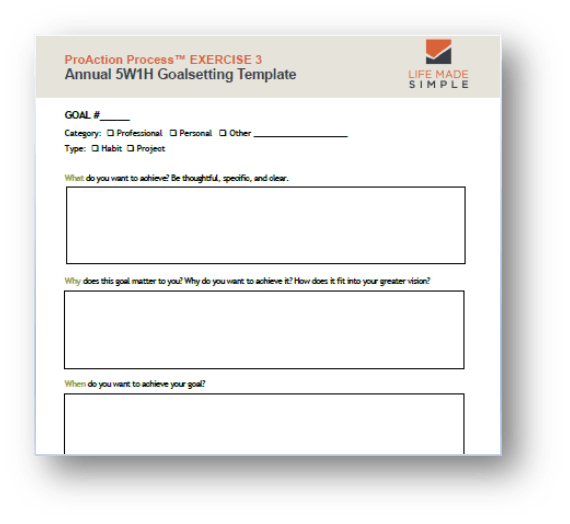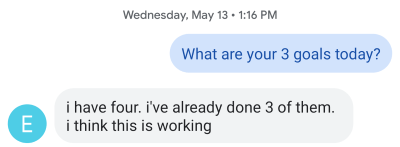
by Lori Vande Krol | Jun 22, 2022 | General Productivity, Goals and Priorities, Motivation, Procrastination, Team Productivity, Time Management
I have a confession to make. Months went by this year before I finally took focused time to set my annual goals. While I help others to do this daily and understand the importance and benefit of annual goal setting, I was not able to complete the task for myself. I took some time to reflect on my reasons for procrastinating on this task, which helped me to work through and complete the process. Following are a few reasons you might find goal setting difficult as well as some tips and resources to make it simpler.
1. The goal, outcome, or supporting actions, are unclear.
Too many times, I have gotten hung up on taking action because the end result, or the full range of steps I need to take to get there, is not completely clear. I have to remind myself that taking some action is better than nothing at all. Often, as you start to take action the goal and end result becomes clearer.
In his article, The Goal is Not the Point, James Clear says: ” In other words, your goal becomes your compass, not your buried treasure. The goal is your direction, not your destination. The goal is a mission that you are on, a path that you follow. Whatever comes from that path—whatever treasure you happen to find along this journey—well, that’s just fine. It is the commitment to walking the path that matters.”
When the goal or destination is not clear, consider your goal a direction you are heading, and clarify the end result as you go.
2. Setting big goals is scary.
There are many fears that can hold us back from setting and achieving goals. “What if I fail?” or “What if I succeed? Can I handle it? What comes next?” Perhaps it is a fear of change or a fear of losing control that is holding you back. In times like this, you must ask yourself, “What happens if I don’t try?”
Are you willing to live with more of the same? The status quo? Or are you willing to accept some risks and potential challenges in order to grow and achieve more? What great things might happen, for yourself and others, if you succeed? Take time to evaluate your fears. Learn what is driving the fear and anxiety in order to push forward. You may find that you even enjoy the journey.
3. Goal setting has not been successful in the past.
Last fall I was presenting a course on procrastination. When discussing potential reasons for procrastination, I shared that we often fail to take action when the end goal is unclear. An attendee raised her hand and asked, “What is the point of setting goals? It never works.” I challenged her to think more deeply about her hesitation toward goalsetting. I asked if there was possibly something else holding her back. After the presentation, we talked further, and I learned that she had worked for large corporations most of her career. Those companies would go through the annual goalsetting process, but it would end there. Management would not follow through or follow up on the actions required to achieve those goals. Goals were not reviewed regularly. Employees were also unclear on how the company’s goals tied to their own vision and goals. The lack of a full system for goal setting and implementation caused it to fail, and employees no longer trusted the process.
If goal setting has not been successful for you in the past, reflect on the true reasons for this. What can be done differently to improve your chances of success? There are many tools and tips to support individual, team, and company goalsetting. The systems and processes used need to work for everyone involved. Below I share additional resources for successful goalsetting.
The potential reasons for avoiding the task of goal setting are not unlike the reasons for procrastinating any task. The first step is working to understand your unique reasons for avoidance and then to find the right tool and process for you and/or your team. There is no doubt you will grow and achieve more.
Additional Resources for Goal Setting
Goal Setting: A Scientific Guide to Setting and Achieving Goals by James Clear
Mastering Time Management: What To Do Before the To-Do List by Lori Vande Krol
Do You Have a Lot of Big Goals? Focus on What You Know and Love by Lori Vande Krol
The Superman: Goal Achieved by Lori Vande Krol
The ProAction Planner™: a system to turn your annual goals into action throughout the year
FREE DOWNLOAD: Use the button below to receive a free Annual Goal Setting Template

Annual 5W1H Goalsetting Template
FREE DOWNLOAD
It is not too late to set your annual goals for this year! If you’d like assistance with the goal-setting process, or in setting up systems for success, contact Lori at Life Made Simple or schedule your free 30-minute consultation. I’d love to help!

by Lori Vande Krol | Sep 3, 2020 | Goals and Priorities, Habits, Motivation, Procrastination
I have something to confess – I have been a pretty bad cook most of my life. I don’t enjoy it and although I knew my family could be eating healthier, better-cooked meals, I’ve never really had an interest in learning – until recently. For a few reasons I’ll get into later, I decided I would challenge myself to learn how to feed my family in a “cleaner” way. Questions that crossed my mind were: “Where do I start? Do I have the right equipment and tools? Where do I get my groceries? How do I know what “eating clean” means? Will the family like the meals? How much time will it take? Will it even help? How can I change habits after so many years of doing it a different way?” There were a lot of unknowns for me and it was a little scary getting started.
Below I share my process and how you can use this same process to change any habit. It’s never too late to learn and grow!
Know Your “Why” for a Habit Change
Sometimes the most difficult step in changing a habit is deciding to do so. In her book Better Than Before, Gretchen Rubin states “A habit requires no decision from me, because I’ve already decided” (Rubin, 2015, p. 5). But even if you have made the tough decision to work on a habit, change is hard. It’s easy to quit. Things often get harder before they get easier. That is why it is important to be clear about your “why” for learning something new or changing a habit. Your “why” needs to be important enough to drive you to start and to continue when things get rough, which I guarantee they will.
Recently in my work with a client, she shared how she had been struggling with changes in daily working habits. Some days were so mentally draining she would have to take a nap to keep going. We reviewed her “why” and decided she would post a photo or vision board near her desk that reminded her of it daily. Doing this helped her to make better choices, focus her work, and maintain energy to reach her goals.
I have several “whys” for changing the way that I shop, cook, and eat, a few of which include increased food sensitivities in the family, a need to eat well to support exercise and sports, setting a good example for my children to be as healthy as possible, and to challenge myself to learn something new during some Covid-19 related downtime. I was also motivated by the short time I had to put new habits in place before the inevitable craziness that comes with back-to-school activities. All of these “whys” were strong enough priorities to spur me into action and to keep me going on the toughest days.
Research and Find the Best Tools to Support Your Habit
Before choosing the right tools to support your habit, it’s important to be clear on your vision for success and what is needed to help you get there. Will your new habit require enhancements to your current tools and systems or the need for something new? For example, if you are wanting to exercise at home regularly, what type of exercise will help you reach your goals? Do you have the right equipment available?
Or maybe you have decided to create a better habit of planning and scheduling your week. Do you prefer doing so in a paper or digital format? What features does your tool or process need to offer the best chance at success? It is important to analyze your needs and preferences before deciding on the tools that will best support your new habit.
I knew I didn’t have the systems, tools, or knowledge to change our cooking and eating habits on my own. If I was going to be successful, I needed to research and educate myself. I started by Googling “clean eating for families” and reached out to an exercise group I belong to. My research led me to Momables.com and the 30-Day Family KickStart program, which is a 4-week sugar-free, gluten-free, and dairy-free (optional) clean eating program. Momables provided me with weekly menus, shopping lists, and preparation tips. In addition, the program suggested equipment and tools that would support my new habit as well as general education about clean eating.
Find Support and Accountability to Reach your Goals
Creating new habits can be lonely without the right people to support and provide you with accountability and motivation. I found this in a few ways:
 (1) I ensured my family was on board with the new eating plan. If I didn’t have their support, it would not have worked.
(1) I ensured my family was on board with the new eating plan. If I didn’t have their support, it would not have worked.
(2) The creator of Momables, Laura Fuentes, reached out to let me know she was available for any support needed. Her regular email communications also kept me on track and motivated me to continue.
(3) The exercise group I belong to often discusses the need for clean eating to support any training or workouts. Hearing others’ challenges and successes provided motivation when things were hard.
Who can provide you with the support, motivation, knowledge, and accountability you need to succeed in your journey to learn, grow, and develop new habits?
Celebrate and Maintain Your Success
Once you have reached your goal, it is important to recognize it. Celebrate your accomplishment, and then determine how you will maintain your success. My family and I planned two celebrations during our 4-week challenge – after two weeks, we enjoyed s’mores by the fire as a “cheat” night. After we completed the full plan, we celebrated with a trip to the local ice cream shop. Knowing we had these milestones scheduled – that we would be able to enjoy a sugary treat soon – helped to keep us on track the rest of the time.
 Now that we have completed the 4-week kickstart program, we have set a goal to maintain an “80%” clean-eating habit. With the help of a weekly dinner plan from Momables, I now have the knowledge, tools, and resources to continue this new lifestyle. We know we won’t be perfect and I would be crazy to think we are “cured” from sugary foods for good, but we have created healthier habits that we will be able to maintain going forward.
Now that we have completed the 4-week kickstart program, we have set a goal to maintain an “80%” clean-eating habit. With the help of a weekly dinner plan from Momables, I now have the knowledge, tools, and resources to continue this new lifestyle. We know we won’t be perfect and I would be crazy to think we are “cured” from sugary foods for good, but we have created healthier habits that we will be able to maintain going forward.
Depending on the habit or change you work to develop, you may not be perfect all of the time and that’s okay. What is important is that you have systems in place to maintain what you have started and can get back on track quickly and easily. Don’t be too hard on yourself and be sure to celebrate the wins.
A Process for Changing or Forming a Habit
After 20 years of the excuses “I hate to cook” or “I don’t know how to cook” as a reason for not learning how to do better, I am proof that it is never too late to learn and change. The techniques and knowledge I gained over those 4 weeks have provided me the basis I need to continue with better habits for myself and my family. Whatever it is you feel you could do better, decide to do it, and then follow this process for success:
- Know your “why”
- Research and find the best tools
- Find support and accountability
- Celebrate and maintain your success
Please share your goals and progress. And if you need assistance with the process, don’t hesitate to reach out for coaching support.
Learn more about Life Made Simple’s Productivity Coaching Plans.
Sources:
Rubin, Gretchen. Better Than Before. New York: Broadway Books, 2015. Print. p. 5.
Momables. www.Momables.com/. Accessed August 2020.

by Lori Vande Krol | May 21, 2020 | Motivation, Procrastination, Task and Project Management, Time Management
“I have so much to do and I just can’t make myself do anything.” This is what I heard from my teenage daughter last week when I walked into her bedroom. Emma is a junior in high school and was trying to juggle three college placement tests, preparation for two choir auditions, and homework for four classes, all on her own and online due to Covid-19. I immediately put on my “productivity consultant hat” and asked her, “Have you made a list? Did you schedule everything into your bullet journal? Are you focusing on what has to be done this week?” She continued, “I’ve done all the things, mom, but nothing is working.”
Do you ever feel overwhelmed by a lengthy to-do list, and all of it feels of equal importance? Sometimes we can feel so much anxiety by looking at our many to-do’s that we don’t know where to start, and the methods and habits that have worked in the past just aren’t working now. Below I share a couple of quick tips to help you get through the most overwhelming of times.
Choose One Thing to Focus on Right Now
Continuing with the example of my daughter’s stressful situation, I asked her, “Why don’t you choose three things to focus on and forget about the rest? Just work to check those off your list one by one to feel a sense of accomplishment.” I knew that once she got those first three things done, she would feel a little better about moving to the next on her list. After hearing that she had also tried this “trick” and it still didn’t kick-start her motivation, I left her with, “Okay, turn on your relaxing music, chose one thing to do right now, and then we will talk again.”
During the most stressful times, you may need to pare back to the most basic productivity strategy – choose just one thing to focus on right now. Ask yourself, “What is the next action I need to take to move a project or task forward?” Do that and then find the next thing to focus on. Soon you should start to feel a sense of control over your to-do’s, your stress levels will decrease, and you can work to get a better handle on the rest of your list.
Choose Three Things to Focus On Today
Later that morning, Emma explained that she had been thinking about the “choose three things” method and wondered if it hadn’t worked in the past because she didn’t write her goals down – instead, she had just determined in her head what three tasks she would do. I told her I would check in with her via text for the next few days to remind her to write down her three goals and check on her progress. Here was the first day’s response:

Success! At least for that day. This extra act of writing down her goals added to the intentionality of the actions and was just enough to get her over her productivity hurdle. The next day’s text was answered with a list of her three goals for that day. Emma may not continue this habit every day moving forward. Instead, she will likely go back to her normal method of weekly planning in her bullet journal. But it was what she needed to get through the high stress levels she was encountering at that time.
When to Use This Simple Process for Increased Productivity
As discussed, using the process of choosing three goals each day is a great tool during times of high stress or feelings of extreme overwhelm. This is also a great process to use if you haven’t yet developed a weekly and/or daily planning habit. Begin with a brain dump of all of your to do’s. Get them off your mind and on paper, or in digital form. Prioritize them if you can. Then, each morning choose three goals to focus on that day.
- Each morning, choose three things you will accomplish today.
- Write them down. Consider sharing them with someone.
- Get to work!
What’s Next?
Once you complete your three goals for the day, celebrate, and then choose the next 1-3 actions. Soon you will have more control and a better perspective of your to-do’s. When you are ready to move to the next level of weekly and daily planning, take a look at “What Should I Do Right Now?” for additional planning tips.
If you struggle with goal setting, prioritization, planning, or are just feeling overwhelmed with work and life, please reach out to me or schedule your free 30-minute Productivity Assessment. I would love to help you gain control and develop the habits that save you time, energy, and stress.

by Lori Vande Krol | Sep 24, 2019 | Goals and Priorities, Procrastination, Task and Project Management, Team Productivity, Time Management
Have you ever read a book that changed your life? At the recommendation of several friends in the business world, I recently completed Building a Story Brand by Donald Miller. Donald promises that after reading his book you will be able to “use the 7 elements of great storytelling to grow your business.” Before reading Building a Story Brand, I had never been excited about marketing. It does not come naturally to me, I am not good at it, and it is not fun for me….at least these have been my excuses for when I don’t put in the time and effort needed as a business owner.
The content of Building a Story Brand really struck a chord with me and provided me with a way to view “marketing” like I haven’t before, but this isn’t a book review. The truly eye-opening result of the book was that I was reminded of the importance of two things for any successful endeavor:
- A clear vision that resonates and
- a simple project plan.
While I had hired marketing experts in the past to assist me with specific pieces of my branding and marketing, I did not have an overriding plan that resonated with me. This book provided that for me. For someone who helps clients clarify their goals and develop customized productivity plans for a living, I’m embarrassed to admit it took this long to realize what I was missing!
Building a Plan for Productivity
What have you been procrastinating, or avoiding, in work or life? What projects have been slow-moving or “stuck” within your office or business? What reasons have you, or your team, used for not taking action? Could it be that you also need a clear, concise plan that resonates? Project plans not only provide the step-by-step tasks needed to reach your goals but can also help you “get unstuck” and motivate you and your team. (For more tips on tackling procrastination, check out “Reduce Procrastination with 3 Powerful Steps”.)
Parts of a Successful Project Plan
When creating or revising a plan, be sure to include the following important aspects:
Create a Vision for Success
What will the final result look like? How will success feel? What will you be able to do that you can’t do now? What drives you and your team towards this vision?
Determine Your Goals and Actions
Define the high-level goals that are needed to reach your end vision and put specific action steps behind them. Don’t make it too difficult at first – you can fine tune as you go.
Evaluate Your Resources
What human, technology, budgetary and other resources are needed to reach your goals? What do you have now and what additional resources are needed?
Schedule Your Actions
Once you have your actions and resources defined, you can determine a schedule for completion. Consider choosing an end-date and working backwards. Or, choose intermediate deadlines for the high-level goals and then schedule your action steps to meet those dates.
Celebrate and Maintain Your Success
Celebration is a great bridge between project completion and maintenance. You will also need to determine how you will maintain your success.
Consider Your Risks and Obstacles
For most projects or goals, it’s also important to consider and discuss any risks and obstacles you might encounter along the way and how they’ll be addressed.
Just Get Started
 The most important thing is to get started, or “just do it” as Nike® would say. If you don’t have a complete, detailed vision or if you aren’t yet sure of the resources needed for each goal or task, that’s okay. You can start with a good framework and add to it – or even change direction if needed – as you go. Start small to gain momentum. Don’t waste another day before tackling that project, writing your book, or getting healthier. Whatever your end goal, just jot down your vision, goals and tasks and take action!
The most important thing is to get started, or “just do it” as Nike® would say. If you don’t have a complete, detailed vision or if you aren’t yet sure of the resources needed for each goal or task, that’s okay. You can start with a good framework and add to it – or even change direction if needed – as you go. Start small to gain momentum. Don’t waste another day before tackling that project, writing your book, or getting healthier. Whatever your end goal, just jot down your vision, goals and tasks and take action!
P.S. If plan development isn’t your thing, I’d love to help. I’ll listen to your needs, help you fine-tune your vision and goals, and document the action steps needed to reach your vision. I can also remain by your side to provide support and accountability as you walk through your customized plan. Schedule your free 30 minute productivity assessment to see if productivity coaching is right for you.

by Lori Vande Krol | Mar 15, 2019 | Delegation, Organization, Procrastination, Time Management
Clutter is delayed decisions – whether it be paper clutter, email clutter, mind clutter or any other type of clutter in your home or office. Piles start because you are postponing making a decision on an item…then another… then another… So how can we simplify the choices that we need to make each day?
Following are 5 tips to help simplify your decision-making and reduce your piles.
Delegate
What could be better done, or used, by someone else? Choose those things that you love to do or love to look at and find someone else to take care of the rest. If you need help determining what to handle yourself and what to delegate, or donate, don’t be afraid to call in a professional or an unbiased friend to assist.
Gain Perspective
Try to step back and see yourself as others see you in your situation. This can serve as a reality check and open your eyes to things you have been avoiding. If you are having trouble with this exercise, find someone you trust and ask for his or her opinion — but be ready for the answers and keep an open mind.
Use a Timer
When a task seems overwhelming, or when you find yourself spending all day researching a decision on the internet or clearing out your email inbox, a timer is a wonderful tool. Set it for 10 minutes, 30 minutes or 1 hour depending on the task. Work diligently during this time to make the appropriate decision(s). The task will seem less overwhelming and take much less energy.
Have a System
Having the appropriate systems and tools in place is very important in simplifying your decision-making. For example, the ART System™ works wonderfully for addressing your paper and electronic “piles.” Every item should either be acted on (or delegated to someone else to act upon), filed away for future reference, or tossed. With effective tools in place that work for your needs and personality, these decisions become much simpler.
Let Go of Perfectionism
You might be surprised at how many of my clients are perfectionists. They say they are cluttered and disorganized because if something can’t be perfect, they don’t want to do it at all. Sound familiar? As a recovering perfectionist myself, I completely understand this feeling. But sometimes you need to determine that ‘good is good enough’ and move on. One way I have found to address this issue within my home is to hire a cleaning lady (see #1 – Delegate). If I clean my own home, I would spend far too much time on the picky details, while she is not only much more efficient at cleaning my home, but she knows when good is good enough.
Another tip for addressing perfectionism is to repeat to yourself a phrase I learned from a mentor, Barbara Hemphill. Barbara often says “Doing something is better than doing nothing at all.” If I didn’t believe and live by this phrase every day, you might not be reading this article right now. Is it perfect? No. Is it good enough. I hope so.

by Lori Vande Krol | Nov 12, 2017 | Procrastination, Time Management
Many of us struggle at times with getting things done due to procrastination. There are many reasons that we might put something off for later; it is a task we don’t enjoy, it appears overwhelming, we aren’t prioritizing it, we don’t have the right knowledge or tools or we just don’t know where to start. Following are 3 tips to help move forward towards productive action.
1. Make better decisions. Much of our clutter, including the longer-than-necessary to-do list, is due to postponed decisions. In a prior article, I shared the File-Act-Toss™ process and the Magic 6™ tools needed to more easily make decisions. But even with the right tools and systems in place, there are times we just seem to be stuck. The task or project may not fit our current vision and goals, we may be waiting on someone else to move the project along or we may not be the right person for the job. Asking yourself “What would need to change in order for me to take action?” can provide powerful guidance for moving forward.
2. Use an action verb. When a task or project seems overwhelming or you just aren’t sure where to start, take it one step at a time. Determine what needs to happen next, using an action verb to state the task. For example, ‘Call Joan today,’ ‘Create a list of newsletter ideas,’ or ‘Write an outline for Chapter 1.’ Once that step is completed, determine the next step using an action verb and so on.
3. Eat that frog. To use the term made popular in David Allen’s book, Eat That Frog!: 21 Great Ways to Stop Procrastinating and Get More Done in Less Time , Eat That Frog refers to attacking those tasks we have been putting off because it is something we just don’t like, or want, to do – i.e. the frogs. Often these tasks can have the largest impact on our work or life. Complete the frog first, before anything else. You are then able to more easily move through your day knowing the “biggest and worst” task has already been completed.
These are three very simple tasks that, when done regularly, can have a huge impact on the way that you live and work. I’d love to hear your success stories after putting them into practice. Send me an email or post a comment on our Facebook page.





 Now that we have completed the 4-week kickstart program, we have set a goal to maintain an “80%” clean-eating habit. With the help of a weekly dinner plan from Momables, I now have the knowledge, tools, and resources to continue this new lifestyle. We know we won’t be perfect and I would be crazy to think we are “cured” from sugary foods for good, but we have created healthier habits that we will be able to maintain going forward.
Now that we have completed the 4-week kickstart program, we have set a goal to maintain an “80%” clean-eating habit. With the help of a weekly dinner plan from Momables, I now have the knowledge, tools, and resources to continue this new lifestyle. We know we won’t be perfect and I would be crazy to think we are “cured” from sugary foods for good, but we have created healthier habits that we will be able to maintain going forward.


 The most important thing is to get started, or “just do it” as Nike® would say. If you don’t have a complete, detailed vision or if you aren’t yet sure of the resources needed for each goal or task, that’s okay. You can start with a good framework and add to it – or even change direction if needed – as you go.
The most important thing is to get started, or “just do it” as Nike® would say. If you don’t have a complete, detailed vision or if you aren’t yet sure of the resources needed for each goal or task, that’s okay. You can start with a good framework and add to it – or even change direction if needed – as you go. 

Recent Comments